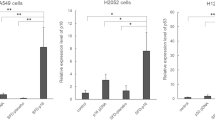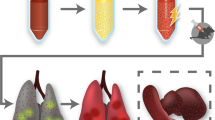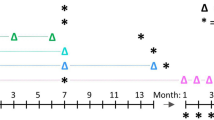Abstract
Revealing the lung tumor genome has directed the current treatment strategies toward targeted therapy. First line treatments targeting the genome of lung tumor cells have been approved and are on the market. However, they are limited by the small number of patients with the current investigated genetic mutations. Novel treatment administration modalities have been also investigated in an effort to increase the local drug deposition and disease control. In the current study, we investigated the safety of the new nonviral vector 2-diethylaminoethyl-dextran methyl methacrylate copolymer (DDMC; Ryujyu Science), which belongs to the 2-diethylaminoethyl-dextran family by aerosol administration. Thirty male BALBC mice, 2 month old, were included and divided into three groups. However, pathological findings indicated severe emphysema within three aerosol sessions. In addition, the CytoViva technique was applied for the first time to display the nonviral particles within the pulmonary tissue and emphysema lesions, and a spectral library of the nonviral vector was also established. Although our results in BALBC mice prevented us from further investigation of the DDMC nonviral vector as a vehicle for gene therapy, further investigation in animals with larger airways is warranted to properly evaluate the safety of the vector.
This is a preview of subscription content, access via your institution
Access options
Subscribe to this journal
Receive 12 print issues and online access
$259.00 per year
only $21.58 per issue
Buy this article
- Purchase on Springer Link
- Instant access to full article PDF
Prices may be subject to local taxes which are calculated during checkout







Similar content being viewed by others
References
Liao BC, Lin CC, Yang JC . First-line management of egfr-mutated advanced lung adenocarcinoma: recent developments. Drugs 2013; 73: 357–369.
Gridelli C, De Marinis F, Di Maio M, Cortinovis D, Cappuzzo F, Mok T . Gefitinib as first-line treatment for patients with advanced non-small-cell lung cancer with activating epidermal growth factor receptor mutation: Review of the evidence. Lung Cancer 2011; 71: 249–257.
Li T, Kung HJ, Mack PC, Gandara DR . Genotyping and genomic profiling of non-small-cell lung cancer: implications for current and future therapies. J Clin Oncol 2013; 31: 1039–1049.
Nelson V, Ziehr J, Agulnik M, Johnson M . Afatinib: emerging next-generation tyrosine kinase inhibitor for NSCLC. Onco Targets Ther 2013; 6: 135–143.
Gadgeel SM, Wozniak A . Preclinical rationale for PI3K/Akt/mTOR pathway inhibitors as therapy for epidermal growth factor receptor inhibitor-resistant non-small-cell lung cancer. Clin Lung Cancer 2013; S1525-7304: 00266-5.
Belalcazar A, Azana D, Perez CA, Raez LE, Santos ES . Targeting the Met pathway in lung cancer. Expert Rev Anticancer Ther 2012; 12: 519–528.
Neal JW, Wakelee HA . Aflibercept in lung cancer. Expert Opin Biol Ther 2013; 13: 115–120.
Thomas A, Maltzman J, Hassan R . Farletuzumab in lung cancer. Lung Cancer 2013; 80: 15–18.
Lu S, Yu YF . Maintenance therapy for NSCLC: consensus and controversy. Chin J Cancer Res 2011; 23: 254–258.
Ihbe-Heffinger A, Paessens B, Berger K, Shlaen M, Bernard R, von Schilling C et al. The impact of chemotherapy-induced side effects on medical care usage and cost in German hospital care - an observational analysis on non-small-cell lung cancer patients. Support Care Cancer 2013; 21: 1665–1675.
Zarogoulidis K, Papagiannis A, Ziogas E, Fahantidou E, Dermitzakis G, Gioulekas D et al. Management of chemotherapy-related anaemia with low-dose recombinant human erythropoietin in patients with small cell lung cancer. Eur J Cancer 1997; 33: 2428–2431.
Zarogoulidis P, Eleftheriadou E, Sapardanis I, Zarogoulidou V, Lithoxopoulou H, Kontakiotis T et al. Feasibility and effectiveness of inhaled carboplatin in NSCLC patients. Invest New Drugs 2012; 30: 1628–1640.
Celikoglu F, Celikoglu SI, Goldberg EP . Bronchoscopic intratumoral chemotherapy of lung cancer. Lung Cancer 2008; 61: 1–12.
Zarogoulidis P, Chatzaki E, Hohenforst-Schmidt W, Goldberg EP, Galaktidou G, Kontakiotis T et al. Management of malignant pleural effusion by suicide gene therapy in advanced stage lung cancer: a case series and literature review. Cancer Gene Ther 2012; 19: 593–600.
Zarogoulidis K, Ziogas E, Papagiannis A, Charitopoulos K, Dimitriadis K, Economides D et al. Interferon alpha-2a and combined chemotherapy as first line treatment in SCLC patients: a randomized trial. Lung Cancer 1996; 15: 197–205.
Porpodis K, Karanikas M, Zarogoulidis P, Kontakiotis T, Mitrakas A, Esebidis A et al. A case of typical pulmonary carcinoid tumor treated with bronchoscopic therapy followed by lobectomy. J Multidiscip Healthc 2012; 5: 47–51.
Zarogoulidis K, Eleftheriadou E, Kontakiotis T, Gerasimou G, Zarogoulidis P, Sapardanis I et al. Long acting somatostatin analogues in combination to antineoplastic agents in the treatment of small cell lung cancer patients. Lung Cancer 2012; 76: 84–88.
Hecht JR, Farrell JJ, Senzer N, Nemunaitis J, Rosemurgy A, Chung T et al. EUS or percutaneously guided intratumoral TNFerade biologic with 5-fluorouracil and radiotherapy for first-line treatment of locally advanced pancreatic cancer: a phase I/II study. Gastrointest Endosc 2012; 75: 332–338.
Weiss GR, Grosh WW, Chianese-Bullock KA, Zhao Y, Liu H, Slingluff CL Jr. et al. Molecular insights on the peripheral and intratumoral effects of systemic high-dose rIL-2 (aldesleukin) administration for the treatment of metastatic melanoma. Clin Cancer Res 2011; 17: 7440–7450.
Horev-Drori G, Cooks T, Bittan H, Lazarov E, Schmidt M, Arazi L et al. Local control of experimental malignant pancreatic tumors by treatment with a combination of chemotherapy and intratumoral 224radium-loaded wires releasing alpha-emitting atoms. Transl Res 2012; 159: 32–41.
Sterman DH, Recio A, Carroll RG, Gillespie CT, Haas A, Vachani A et al. A phase I clinical trial of single-dose intrapleural IFN-beta gene transfer for malignant pleural mesothelioma and metastatic pleural effusions: high rate of antitumor immune responses. Clin Cancer Res 2007; 13 (15 Pt 1): 4456–4466.
Zhang J, Wei F, Wang H, Li H, Qiu W, Ren P et al. A novel oncolytic adenovirus expressing Escherichia coli cytosine deaminase exhibits potent antitumor effect on human solid tumors. Cancer Biother Radiopharm 2010; 25: 487–495.
Gautam A, Densmore CL, Xu B, Waldrep JC . Enhanced gene expression in mouse lung after PEI-DNA aerosol delivery. Mol Ther 2000; 2: 63–70.
Zou Y, Tornos C, Qiu X, Lia M, Perez-Soler R . p53 aerosol formulation with low toxicity and high efficiency for early lung cancer treatment. Clin Cancer Res 2007; 13: 4900–4908.
Densmore CL, Kleinerman ES, Gautam A, Jia SF, Xu B, Worth LL et al. Growth suppression of established human osteosarcoma lung metastases in mice by aerosol gene therapy with PEI-p53 complexes. Cancer Gene Ther 2001; 8: 619–627.
Minai-Tehrani A, Park YC, Hwang SK, Kwon JT, Chang SH, Park SJ et al. Aerosol delivery of kinase-deficient Akt1 attenuates Clara cell injury induced by naphthalene in the lungs of dual luciferase mice. J Vet Sci 2011; 12: 309–317.
Zarogouldis P, Karamanos NK, Porpodis K, Domvri K, Huang H, Hohenforst-Schimdt W et al. Vectors for inhaled gene therapy in lung cancer. Application for nano oncology and safety of bio nanotechnology. Int J Mol Sci 2012; 13: 10828–10862.
Zarogoulidis P, Karamanos NK, Porpodis K, Domvri K, Huang H, Hohenforst-Schmidt W et al. Vectors for inhaled gene therapy in lung cancer. Application for nano oncology and safety of bio nanotechnology. Int J Mol Sci 2012; 13: 17290–17291.
Chirmule N, Hughes JV, Gao GP, Raper SE, Wilson JM . Role of E4 in eliciting CD4 T-cell and B-cell responses to adenovirus vectors delivered to murine and nonhuman primate lungs. J Virol 1998; 72: 6138–6145.
Hart SL, Knight AM, Harbottle RP, Mistry A, Hunger HD, Cutler DF et al. Cell binding and internalization by filamentous phage displaying a cyclic Arg-Gly-Asp-containing peptide. J Biol Chem 1994; 269: 12468–12474.
Montier T, Delepine P, Benvegnu T, Ferrieres V, Miramon ML, Dagorn S et al. Efficient gene transfer into human epithelial cell lines using glycosylated cationic carriers and neutral glycosylated co-lipids. Blood Cells Mol Dis 2004; 32: 271–282.
Frederiksen KS, Abrahamsen N, Cristiano RJ, Damstrup L, Poulsen HS . Gene delivery by an epidermal growth factor/DNA polyplex to small cell lung cancer cell lines expressing low levels of epidermal growth factor receptor. Cancer Gene Ther 2000; 7: 262–268.
Kim HW, Park IK, Cho CS, Lee KH, Beck GR Jr., Colburn NH et al. Aerosol delivery of glucosylated polyethylenimine/phosphatase and tensin homologue deleted on chromosome 10 complex suppresses Akt downstream pathways in the lung of K-ras null mice. Cancer Res 2004; 64: 7971–7976.
Gautam A, Densmore CL, Melton S, Golunski E, Waldrep JC . Aerosol delivery of PEI-p53 complexes inhibits B16-F10 lung metastases through regulation of angiogenesis. Cancer Gene Ther 2002; 9: 28–36.
Godbey WT, Wu KK, Mikos AG . Tracking the intracellular path of poly(ethylenimine)/DNA complexes for gene delivery. Proc Natl Acad Sci USA 1999; 96: 5177–5181.
Davies LA, McLachlan G, Sumner-Jones SG, Ferguson D, Baker A, Tennant P et al. Enhanced lung gene expression after aerosol delivery of concentrated pDNA/PEI complexes. Mol Ther 2008; 16: 1283–1290.
Jere D, Yoo MK, Arote R, Kim TH, Cho MH, Nah JW et al. Poly (amino ester) composed of poly (ethylene glycol) and aminosilane prepared by combinatorial chemistry as a gene carrier. Pharm Res 2008; 25: 875–885.
Pfeifer C, Hasenpusch G, Uezguen S, Aneja MK, Reinhardt D, Kirch J et al. Dry powder aerosols of polyethylenimine (PEI)-based gene vectors mediate efficient gene delivery to the lung. J Control Release 2011; 154: 69–76.
Pitard B, Bello-Roufai M, Lambert O, Richard P, Desigaux L, Fernandes S et al. Negatively charged self-assembling DNA/poloxamine nanospheres for in vivo gene transfer. Nucleic Acids Res 2004; 32: e159.
Kawabata A, Baoum A, Ohta N, Jacquez S, Seo GM, Berkland C et al. Intratracheal administration of a nanoparticle-based therapy with the angiotensin II type 2 receptor gene attenuates lung cancer growth. Cancer Res 2012; 72: 2057–2067.
Manunta MD, McAnulty RJ, Tagalakis AD, Bottoms SE, Campbell F, Hailes HC et al. Nebulisation of receptor-targeted nanocomplexes for gene delivery to the airway epithelium. PLoS One 2011; 6: e26768.
Zhong Z, Wan Y, Han J, Shi S, Zhang Z, Sun X . Improvement of adenoviral vector-mediated gene transfer to airway epithelia by folate-modified anionic liposomes. Int J Nanomedicine 2011; 6: 1083–1093.
Jin H, Kim TH, Hwang SK, Chang SH, Kim HW, Anderson HK et al. Aerosol delivery of urocanic acid-modified chitosan/programmed cell death 4 complex regulated apoptosis, cell cycle, and angiogenesis in lungs of K-ras null mice. Mol Cancer Ther 2006; 5: 1041–1049.
Mohammadi Z, Dorkoosh FA, Hosseinkhani S, Gilani K, Amini T, Najafabadi AR et al. in vivo transfection study of chitosan-DNA-FAP-B nanoparticles as a new non viral vector for gene delivery to the lung. Int J Pharm 2011; 421: 183–188.
Schughart K, Rasmussen UB . Solvoplex synthetic vector for intrapulmonary gene delivery. Preparation and use. Methods Mol Med 2002; 69: 83–94.
Delepine P, Guillaume C, Floch V, Loisel S, Yaouanc J, Clement J et al. Cationic phosphonolipids as nonviral vectors: in vitro and in vivo applications. J Pharm Sci 2000; 89: 629–638.
Arote R, Kim TH, Kim YK, Hwang SK, Jiang HL, Song HH et al. A biodegradable poly(ester amine) based on polycaprolactone and polyethylenimine as a gene carrier. Biomaterials 2007; 28: 735–744.
Gautam A, Densmore CL, Golunski E, Xu B, Waldrep JC . Transgene expression in mouse airway epithelium by aerosol gene therapy with PEI-DNA complexes. Mol Ther 2001; 3: 551–556.
Rudolph C, Muller RH, Rosenecker J . Jet nebulization of PEI/DNA polyplexes: physical stability and in vitro gene delivery efficiency. J Gene Med 2002; 4: 66–74.
Onishi Y, Eshita Y, Murashita A, Mizuno M, Yoshida J . Characteristics of DEAE-dextran-MMA graft copolymer as a nonviral gene carrier. Nanomedicine 2007; 3: 184–191.
Eshita Y, Higashihara J, Onishi M, Mizuno M, Yoshida J, Takasaki T et al. Mechanism of introduction of exogenous genes into cultured cells using DEAE-dextran-MMA graft copolymer as non-viral gene carrier. Molecules 2009; 14: 2669–2683.
Onishi Y, Eshita Y, Murashita A, Mizuno M, Yoshida J . A novel vector of 2-diethylaminoethyl(DEAE)-dextran-mma graft copolymer for non-viral gene deliver. J Gene Med 2008; 10: 472.
Onishi Y, Kikuchi Y . Study of the complex between RNA and DEAE-dextran. Kobunshi Ronbunshu 2004; 61: 139–143.
Onishi Y, Maruno S, Kamiya S, Hokkoku S, Hasegawa M . Preparation and characteristics of dextran-methyl methacrylate graft copolymer. Polymer 1978; 19: 1325–1328.
Rau JL . Design principles of liquid nebulization devices currently in use. Respir Care 2002; 47: 1257–1275.
Catanese DJ Jr., Fogg JM, Schrock DE 2nd, Gilbert BE, Zechiedrich L . Supercoiled Minivector DNA resists shear forces associated with gene therapy delivery. Gene Ther 2012; 19: 94–100.
Tolmachov OE . Self-entanglement of long linear DNA vectors using transient non-B-DNA attachment points: a new concept for improvement of non-viral therapeutic gene delivery. Med Hypotheses 2012; 78: 632–635.
Cipolla DC, Gonda I, Shak S, Kovesdi I, Crystal R, Sweeney TD . Coarse spray delivery to a localized region of the pulmonary airways for gene therapy. Hum Gene Ther 2000; 11: 361–371.
Beck SE, Laube BL, Barberena CI, Fischer AC, Adams RJ, Chesnut K et al. Deposition and expression of aerosolized rAAV vectors in the lungs of Rhesus macaques. Mol Ther 2002; 6: 546–554.
Hasenpusch G, Pfeifer C, Aneja MK, Wagner K, Reinhardt D, Gilon M et al. Aerosolized BC-819 inhibits primary but not secondary lung cancer growth. PLoS One 2011; 6: e20760.
Colonna C, Conti B, Genta I, Alpar OH . Non-viral dried powders for respiratory gene delivery prepared by cationic and chitosan loaded liposomes. Int J Pharm 2008; 364: 108–118.
Zarogoulidis P, Papanas N, Kouliatsis G, Spyratos D, Zarogoulidis K, Maltezos E . Inhaled insulin: too soon to be forgotten? J Aerosol Med Pulm Drug Deliv 2011; 24: 213–223.
Xu CX, Jere D, Jin H, Chang SH, Chung YS, Shin JY et al. Poly(ester amine)-mediated, aerosol-delivered Akt1 small interfering RNA suppresses lung tumorigenesis. Am J Respir Crit Care Med 2008; 178: 60–73.
Tehrani AM, Hwang SK, Kim TH, Cho CS, Hua J, Nah WS et al. Aerosol delivery of Akt controls protein translation in the lungs of dual luciferase reporter mice. Gene Ther 2007; 14: 451–458.
Kootstra NA, Verma IM . Gene therapy with viral vectors. Annu Rev Pharmacol Toxicol 2003; 43: 413–439.
Boussif O, Lezoualc’h F, Zanta MA, Mergny MD, Scherman D, Demeneix B et al. A versatile vector for gene and oligonucleotide transfer into cells in culture and in vivo: polyethylenimine. Proc Natl Acad Sci USA 1995; 92: 7297–7301.
Thomas M, Ge Q, Lu JJ, Chen J, Klibanov AM . Cross-linked small polyethylenimines: while still nontoxic, deliver DNA efficiently to mammalian cells in vitro and in vivo. Pharm Res 2005; 22: 373–380.
Anchordoquy TJ, Koe GS . Physical stability of nonviral plasmid-based therapeutics. J Pharm Sci 2000; 89: 289–296.
Mahato RI, Rolland A, Tomlinson E . Cationic lipid-based gene delivery systems: pharmaceutical perspectives. Pharm Res 1997; 14: 853–859.
Cherng JY, van de Wetering P, Talsma H, Crommelin DJ, Hennink WE . Freeze-drying of poly((2-dimethylamino)ethyl methacrylate)-based gene delivery systems. Pharm Res 1997; 14: 1838–1841.
Bandyopadhyay P, Ma X, Linehan-Stieers C, Kren BT, Steer CJ . Nucleotide exchange in genomic DNA of rat hepatocytes using RNA/DNA oligonucleotides. Targeted delivery of liposomes and polyethyleneimine to the asialoglycoprotein receptor. J Biol Chem 1999; 274: 10163–10172.
McLachlan G, Davidson H, Holder E, Davies LA, Pringle IA, Sumner-Jones SG et al. Pre-clinical evaluation of three non-viral gene transfer agents for cystic fibrosis after aerosol delivery to the ovine lung. Gene Ther 2011; 18: 996–1005.
Koehler DR, Frndova H, Leung K, Louca E, Palmer D, Ng P et al. Aerosol delivery of an enhanced helper-dependent adenovirus formulation to rabbit lung using an intratracheal catheter. J Gene Med 2005; 7: 1409–1420.
Labiris NR, Dolovich MB . Pulmonary drug delivery. Part I: physiological factors affecting therapeutic effectiveness of aerosolized medications. Br J Clin Pharmacol 2003; 56: 588–599.
Labiris NR, Dolovich MB . Pulmonary drug delivery. Part II: the role of inhalant delivery devices and drug formulations in therapeutic effectiveness of aerosolized medications. Br J Clin Pharmacol 2003; 56: 600–612.
Acknowledgements
We thank the Director of the experimental animal laboratory of ‘Theiagenio’ Anticancer Hospital; Frideriki Patakiouta for her support by using the installations of the laboratory. We also thank the Associate Professor of the Technical Institute of Aristotle University of Thessaloniki; Dr Paul Zarogoulidis thanks the Assistant Professor Chris Ritzoulis, Technical Institute of Food Administration, Aristotle University of Thessaloniki, Greece for his technical assistance in measuring the aerosol droplets with the Mastesizer 2000 laser scattering apparatus (Malvern). In addition, he thanks Jane F Century Chief Operating Officer, Penn-Century, Inc. http://www.penncentury.com for providing her technical expertise and material in order for this effort to be completed and presented. Finally, we thank the veterinarians; Kyriaki Papadimitriou and Froso Papagianni for the supervision of the animals throughout the project.
Author information
Authors and Affiliations
Corresponding author
Ethics declarations
Competing interests
The authors declare no conflict of interest.
Rights and permissions
About this article
Cite this article
Zarogoulidis, P., Hohenforst-Schmidt, W., Darwiche, K. et al. 2-diethylaminoethyl-dextran methyl methacrylate copolymer nonviral vector: still a long way toward the safety of aerosol gene therapy. Gene Ther 20, 1022–1028 (2013). https://doi.org/10.1038/gt.2013.27
Received:
Revised:
Accepted:
Published:
Issue Date:
DOI: https://doi.org/10.1038/gt.2013.27
Keywords
This article is cited by
-
Medicinal facilities to B16F10 melanoma cells for distant metastasis control with a supramolecular complex by DEAE-dextran-MMA copolymer/paclitaxel
Drug Delivery and Translational Research (2015)
-
A gene therapy induced emphysema model and the protective role of stem cells
Diagnostic Pathology (2014)
-
Intratumoral gene therapy versus intravenous gene therapy for distant metastasis control with 2-Diethylaminoethyl-Dextran Methyl Methacrylate Copolymer Non-Viral Vector–p53
Gene Therapy (2014)



